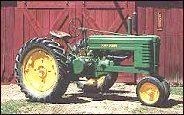
|
|
This is a 1940 John Deere Model B - one of my favorites. It is a "rowcrop" tractor with tricycle front wheels, and rear wheels with cast iron centers. It has a hydraulic power lift, a belt pulley, and a power take off (pto). I have used it out in the field, but this is the one I like to use in parades, and take to shows. |
| Here's the top view of a 1943 John Deere Model B. It is the first tractor I ever bought, in the fall of 1990.Some may save their pennies or wait for their income tax return to buy these antique tractors. It didn't run when I got it, and it was quite a learning experience to get it to run. At that time, I had never driven a tractor in my life! By the way, this picture was taken from the top window of the barn loft, with the camera pointed straight down. |

|
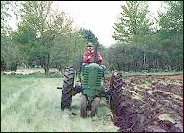
|
|
This was the first time I had ever plowed my land, or any land, for that matter! This tractor is the 1946 Model B, otherwise known as "Kermit". It's not always easy being green! My land is a bit rocky, to say the least, and the plow I used was not in the best of condition; so this was another learning experience. |
| My 1950 Model B is equipped with a bucket loader. The snow bucket is shown here. It also came with the manure bucket, which is also handy for moving dirt and rocks. The bucket loader is much better for plowing snow than a snowplow; it can lift the snow out of the way rather than just pushing it aside when there is too much snow and nowhere to put it! | |
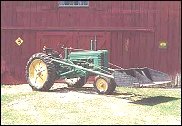
|
Antique John Deere Implements
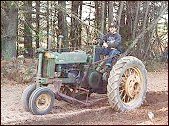
|
|
This 1937 unstyled Model B has a B3 integral two-way plow mounted on it. The plow is raised and lowered by the hydraulics of the tractor. You can plow up and back in the field, and still turn all of the furrows in the same direction. This is especially good for small fields, and for plowing other people's gardens. Mounting and dismounting this plow is one heck of a job, though. |
| The harrow behind this tractor can't be taken anywhere else in the neighborhood because it doesn't have any wheels. But when it is in the straight position it can travel over the lawn without digging it up. It can be set in the cutting position without getting off of the tractor, by simply pulling a rope to unlatch it, backing up to set it, and releasing the rope. | |

|

|
|
The 1950 Model B in the asparagus field has a two-row cultivator mounted on it. You are looking at the rear view as it is used in the row. Work that used to take me over an hour with my eight-horse rototiller can now be done in ten minutes! The cultivator is raised and lowered by hydraulic power, and can also be adjusted in height from the driver's seat by locking levers. |
| The spring teeth of the implement tend to ride over big rocks without bending, and each side of the cultivator is spring loaded independently of the other. The sections behind the rear wheels are also separate, and can be adjusted for height by changing the number of links in the chain that supports them. The whole rig raises and drops with one lever. |
| This cultivator was known as the "quick-tache" style. It can be attached and detached very quickly by just one man. All of the actual "mountings" remain on the tractor. When everything is disconnected, the tractor is simply backed out of the implement. The cultivator can be left on its stanchions, and stored that way. When it is needed again, you just drive into it and reattach. I usually leave it attached to the tractor. | |
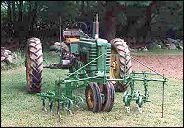
|
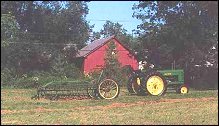
|
|
This high wheeled, rubber-tired, side-delivery hay rake is a real beauty; and it works quite well too. It rakes the mown hay into "windrows". It can also be used for turning over the windrows for drying. This is especially important if the hay gets rained on. There is a Murphy's law concerning cutting hay, very similar to washing your car. |
| The rake is quite a rattling contraption when it is operating, but it does a surprisingly clean job. It is awkward to use around trees, and it leaves clumps when turning around at the ends of the field. That's why I also need a "dumprake". Anybody know where I can find a John Deere dumprake? | |
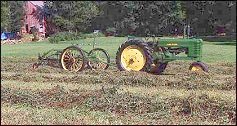
|
Learn more about the implements
or
See more Information about the Model B
or
Return to the Main Page